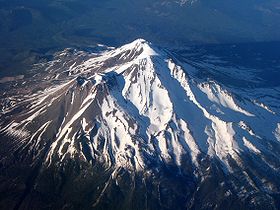Sacred Place: Mount Shasta, Siskiyou County, California
The northwest coast of the United States is home to a series of breathtaking mountain peaks of the Cascade Mountain Range, covered year-round in caps of snow. Many of them are active or potentially active volcanoes, part of the Pacific Ring of Fire. Some figure in Native legends. Mount Shasta, known in the Karuk Language as White Mountain, stands at an elevation of 14,179 feet. It is the second-highest peak in the Cascades nd the fifth highest in California. It's a target of hikers and photographers the world over. However, if Mount Shasta ever does decide to blow, it would be a stratovolcano capable of epic destruction.
Mount Shasta is named for one the Shasta tribe who lived at its base. Other tribes who lived near the mountain include the Okwanuchu, Modoc, Achomawi, Atsugewi, Karuk, Klamat, Winto and Yana. The Siskiyou trail which runs along the base of the mountain and is now an important hiking track, was once a trading path for local tribes. Legends about the mountain abound. According to the Klamath, the mountain was the site of a showdown between good and evil. A good deity, summoned by a Klamath chief, battled with an evil entity which lived in Mount Mazama. Mount Mazama turned itself inside out in a destructive eruption several thousand years ago and is now Crater Lake. Mount Shasta was active at about the same time. Native tribes still consider the mountain to be sacred. It's last eruption was possibly in 1786. In 1826, a Hudson's Bay Company trapper by the name of Peter Skene Ogden first called another nearby mountain, now Mount McLoughlin, as Mount Sastice. By 1841, the name was given as Mount Shasta and given to the present mountain that bears that name.
Mount Shasta is named for one the Shasta tribe who lived at its base. Other tribes who lived near the mountain include the Okwanuchu, Modoc, Achomawi, Atsugewi, Karuk, Klamat, Winto and Yana. The Siskiyou trail which runs along the base of the mountain and is now an important hiking track, was once a trading path for local tribes. Legends about the mountain abound. According to the Klamath, the mountain was the site of a showdown between good and evil. A good deity, summoned by a Klamath chief, battled with an evil entity which lived in Mount Mazama. Mount Mazama turned itself inside out in a destructive eruption several thousand years ago and is now Crater Lake. Mount Shasta was active at about the same time. Native tribes still consider the mountain to be sacred. It's last eruption was possibly in 1786. In 1826, a Hudson's Bay Company trapper by the name of Peter Skene Ogden first called another nearby mountain, now Mount McLoughlin, as Mount Sastice. By 1841, the name was given as Mount Shasta and given to the present mountain that bears that name.




Comments
Post a Comment